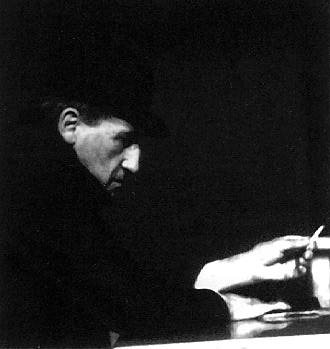
Tadeusz Kantor... il grande mago del teatro
......
.......
Tadeusz Kantor
The great wizard of the theatre
 Tadeusz
Kantor (1915-1990) is universally regarded as one of the
most powerful personalities of the modern theatre and his Cricot
2
was among the most unique theatre companies on the
international circuit.
Tadeusz
Kantor (1915-1990) is universally regarded as one of the
most powerful personalities of the modern theatre and his Cricot
2
was among the most unique theatre companies on the
international circuit.
He gained his first fame internationally as a painter when his work
was included in the first post war UNESCO show in Paris, and he
found himself styled "the representative of non-conformist art
from Eastern Europe".
This brought him immense following among
the young.
Kantor was also a superb graphic artist, but became
renowed world-wide as a leading avant-garde stage designer,
director and producer.
Throughout his life he was tied up with Cracow and did not want to
live anywhere else.
It was there in 1955 that he created the
famous avant-garde theatre called Cricot 2, which, if read
backwards, means (it's a circus" in Polish. Cricot 2 soon became a
household name in Poland and abroad, operating with the same
degree of efficiency in its native Cracow as in Florence and
Nuremberg.
The theatre was regularly invited to France, Italy,
Britain, Germany and the United States.
Over the next 35 years
Kantor's unique theatre did more than 40 international tournees
and won numerous prizes, awards and high distinctions
throughout the world. It was a frequent performer at international
avant-garde theatre festivals.
The prestigious Edinburgh Festival,
for one, invited the group over and over again, which was highly
uncommon in its practice.
Kantor's most "Polish" play is Wielopole,
Wielopole (1980).
Wielopole is the village near Cracow where Kantor was born, while
his father was away dying for Austrian Emperor Franz Josef.
In the
play, he has been resurrected, along with a collection of aunts,
uncles, nuns and priests, other soldiers and life-size puppets
doubling for the characters.
The closest description of what
"happens" in the performance is to call it a sort of passion play,
staged in what Kantor called the "style of the theatre of death".
The dead, to him, were ideal models for actors because like them
they are on the other side of an unbreakable barrier: they are
outsiders.
Kantor liked this kind of sophism and considered that he
was a
researcher in constant movement, never alighting upon a
definitive theory.
His theatre was not a theatre of words, although
words were used. He did not write the plays and did not use
written texts.
He did them, spontaneously, orchestrating the
proceedings from onstage.
When Kantor was no longer alive to
take part in plays staged by his cast, the actors turned, now and
then, towards an empty chair, as if to acknowledge the lost leader
who would have been normally sitting there.
His other best known plays include The
Dead Class (La classe morta) (1976),
Where
Are the Snows of Yesterday (1982) and Let the Artist Die (1985).
His last big work was I shall Never Return (1988), which is
considered Kantor`s artistic testament.
In it the stage of a
theatrical inn is filled with the characters of all Kantor's previous
productions philosophically reflecting the unimportance of human
existence.
Kantor himself called it the "Grand Emballage of the
end of the 20th century - the Pompeii".
Unlike most theatres in Poland, Kantor's was never subsidised by
the Polish government, and the artist ploughed all the money he
made in art to support it.
Throughout his life he was a prolific
painter and as avant-garde as in his theatre. In 1978 the Goethe
Foundation awarded him its annual Rembrandt Prize for his
"genuine contribution to shaping our epoch". That description also
applies to his theatre work.